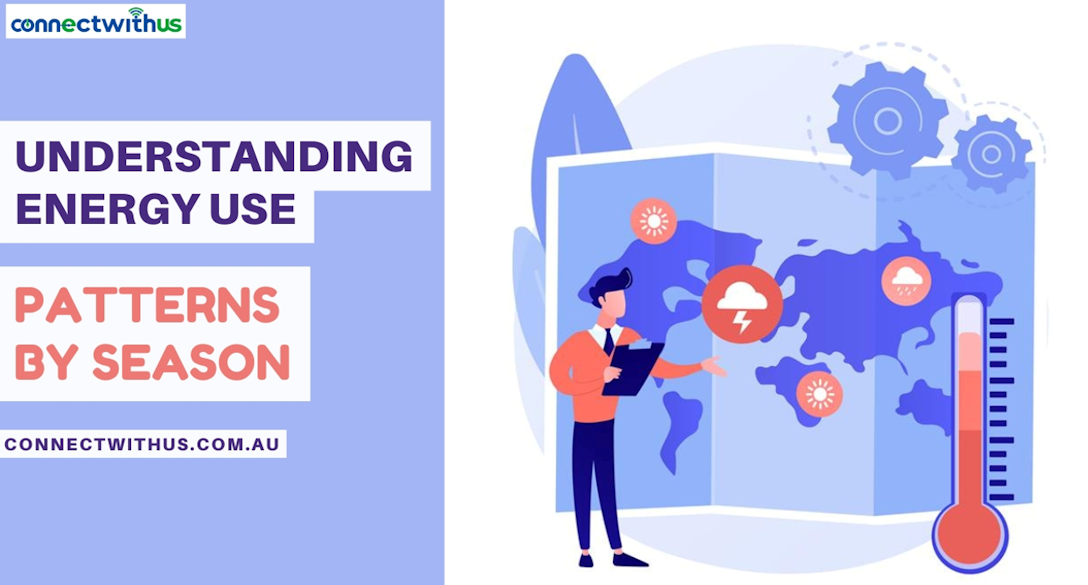Understanding Energy Use Patterns by Season

Australia’s climate changes noticeably across the year. These seasonal changes don’t just affect what we wear or how we travel; they also have a big impact on how much energy we use at home and at work.
Understanding how each season affects energy use can help you better manage your energy bills, plan your consumption, and make smarter choices during your energy provider comparison.
Let’s break down how each season influences your energy usage and what you can do to reduce unnecessary costs throughout the year.
Summer: High Temperatures, Higher Usage
During summer, many Aussie households use more electricity. The main reason is air conditioning. As the temperatures rise, especially in hotter parts of Australia, fans and air conditioning units are used for longer periods of the day and night. This can lead to a significant jump in your power bill.
Appliances like fridges and freezers also work harder in the heat, as they need more energy to stay cool. If your home isn’t properly insulated, it becomes harder to keep the cool air in, which means the air conditioner runs for longer and uses more energy.
To manage energy use in summer, close blinds during the day, seal gaps around windows and doors, and consider using ceiling fans before turning on the air conditioner. Also, check if it’s the right time to Switch Electricity Providers for a better deal before the season kicks in.
Autumn: Mild Weather, Opportunity for Control
Autumn brings cooler temperatures and milder conditions, which usually leads to lower energy use. This is a good time to monitor your electricity habits and make adjustments before the colder months hit. Because heating isn’t required as much and cooling needs drop, your bills should be more stable.
It’s a good season to assess your home’s energy performance. You can check the condition of your insulation, inspect your heating system, and ensure appliances are running efficiently. This helps you prepare for winter without facing a surprise in your next bill.
This season is also ideal for a detailed energy provider comparison. Rates may change throughout the year, and checking now could help you avoid peak-season pricing later. Jump online to use a comparison tool to see if you can snag a better deal.
Winter: The Cost of Staying Warm
Winter is one of the most energy-demanding seasons. Heating is the biggest factor behind the rise in electricity usage. Whether you use a reverse-cycle air conditioner, electric heater, or underfloor heating, your energy bill will likely go up.
Shorter daylight hours also mean lights are turned on earlier and for longer. People tend to spend more time indoors, which leads to increased use of entertainment systems, cooking appliances, and hot water.
To reduce usage during winter, focus on layering clothes, using electric blankets wisely, and heating only the rooms you’re using. If your current plan isn’t cutting it, you might want to make the switch and Connect Electricity Today with a new provider that offers flexible winter rates or off-peak pricing.
Spring: Prepping for Higher Use Again
Spring offers a short break in heavy energy use. Temperatures rise slowly, so the demand for heating and cooling stays relatively low. This is the season to check how your home’s systems handled winter and prepare them for the upcoming summer.
You can clean your air conditioning filters, test fans, and make sure your solar panels (if you have them) are in working order. This reduces the need for emergency repairs when summer hits.
If you’re running a business, it’s worth reviewing your business electricity plans in spring to make sure they suit your upcoming seasonal needs. Often, businesses overlook how quickly usage spikes in summer, especially those that rely on refrigeration or heavy lighting.
Also, spring is a great time to switch electricity providers. Doing it now gives you enough time to see how well the new plan works before the high-demand months arrive.
How Small Daily Habits Make a Big Difference
While seasonal changes play a big role in energy usage, everyday habits also matter. Turning off unused appliances, using energy-efficient lightbulbs, and washing clothes in cold water are simple changes that reduce usage year-round.
Installing a smart meter may help you track how much electricity you’re using each day and at what times. This kind of data can be useful when comparing providers. If your current one doesn’t suit your pattern, an online energy provider comparison will help you find one that does. They are quick and easy.
Note: Energy Plans and Tariffs Shift with the Seasons
Not all Aussie energy plans are designed the same way. Some offer time-of-use pricing, where electricity costs more at peak times (usually evenings). Others have flat rates or seasonal rates. That’s why it’s important to check what type of plan you’re on.
If you’re on a time-of-use tariff, the way you use electricity matters more. Running your washing machine or dishwasher outside of peak hours could make a noticeable difference. If your provider doesn't offer clear value, it might be the right time to switch electricity providers to one that suits your usage better.
Home Improvements That Help All Year
Simple home improvements can help manage energy use across all seasons. These include:
- Sealing gaps and cracks
- Adding or upgrading insulation
- Installing ceiling fans (they help in both summer and winter)
- Using window coverings to control indoor temperature
- Upgrading to energy-efficient appliances
These small upgrades reduce the need for heavy cooling and heating, which are the biggest contributors to energy bills.
Also, if you’ve never done an energy provider comparison, now’s the time. Many people are surprised to find they’re paying more than they need to. Get online and search “energy comparison tool” where you can do a simple review that could result in hundreds of dollars saved each year.
Electricity Needs Are Different for Homes and Businesses
While homeowners often focus on comfort, business owners usually think about costs, performance, and operational hours. Shops, restaurants, offices, and warehouses all use electricity differently, and their seasonal needs also change.
Some businesses use more electricity in winter due to heating needs, while others (like cafes or bakeries) spike in summer because of refrigeration and air conditioning. Knowing these patterns allows better planning and helps you select the right business electricity plans for your needs.
Businesses should also keep an eye on rates and plans available in the market. If the current deal isn’t competitive, look to switch electricity providers and find one that matches your seasonal requirements more effectively.
Wrapping Up
Energy prices can fluctuate during the year, so plan ahead to stay ahead. Waiting until your next bill arrives to take action isn’t the best approach. A proactive mindset helps you avoid bill shock and stay in control of your usage.
If you haven’t looked at your plan in over a year, there’s a strong chance there’s a better option available. Performing a thorough energy provider comparison now will prepare you for upcoming seasonal shifts.
And if you’re moving into a new place or starting a new business location, don’t delay, connect electricity today so your supply is up and running without last-minute stress.












